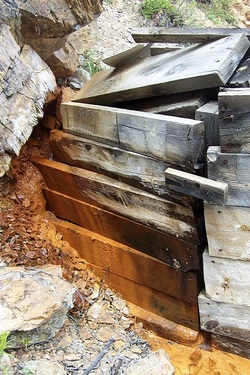Abandoned Mined Land Assessments
Western Water & Land offers a broad spectrum of abandoned mine lands services, including:

- Site Safety and Health Plan Preparation
- Conceptual Site Model Development
- Conceptual Hydrogeologic Model Development
- Surface Water & Groundwater Characterization
- Mine Drainage Assessment
- Mine Waste and Tailings Characterization
- Springs and Seeps Delineation
- Surface and Underground Mapping
- Radiological Surveys
- Benthic Macroinvertebrate Sampling & Surveys
- Human Health and Ecological Risk Evaluation
- Technologies Screening and Alternatives Analysis
- ARARs Identification
- Engineering Evaluation/Cost Analysis (EE/CA) Document Preparation
- Reclamation Design
- Reclamation Management and Oversight
The professionals at Western Water & Land have conducted more than 20 abandoned/inactive mine lands assessments throughout western Colorado and eastern Utah. The assessments have ranged from site-specific studies at individual mine sites to comprehensive studies involving numerous mines within a district. The assessments are commonly performed in accordance with removal action requirements specified in the Comprehensive Environmental Response, Compensation, and Liability Act (CERCLA). A conceptual site model is developed to identify source areas and the media, receptors, and pathways of primary concern. A comprehensive site investigation is performed to characterize the site, assess the nature and extent of contamination in the media of concern, and obtain the information needed to support a streamlined evaluation of the human-health and ecological threats posed by the site. The media commonly sampled during the investigation include mine water drainage, area springs and seeps, receiving streams and tributaries, waste rock comprising the mine dump, tailings where mill operations were associated with the mine, sediment deposited along drainage courses downstream of the mine, and vegetation growing on and around the site. Where nearby residents may be impacted by the mines, water samples are also collected from domestic wells and springs, soil and crop samples are collected from irrigated lands, and soil and produce samples are collected from gardens and orchards. At former uranium mines and mills, characterization activities include radiological surveys, radium-226 correlation, and radon monitoring. Streamlined risk evaluations are completed by comparing sample results to stream standards, risk-based benchmarks established by US EPA and state agencies, and risk management criteria developed by the US BLM for mine sites Potential technologies for risk reduction are screened and applicable or relevant and appropriate requirements (ARARs) are identified. Retained technologies are assembled to form potential removal action alternatives for reduction of human-health and ecological threats. The potential alternatives are analyzed and compared based on effectiveness, implementability, and cost.
